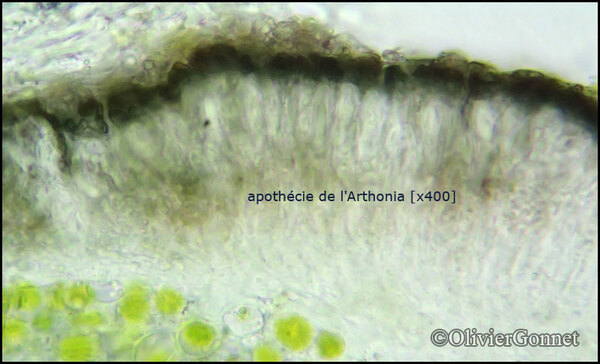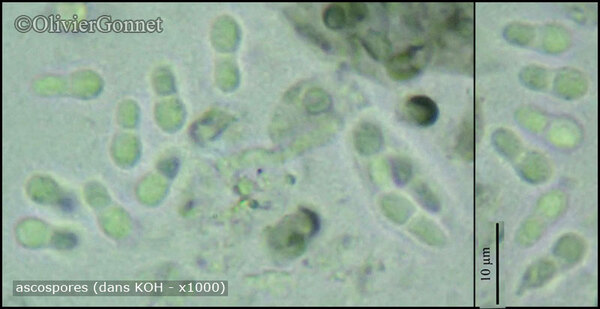Arthonia subvarians Nyl.
Flora, 51: 345, 1868
Synonyms: Arthonia galactinaria Leight.
Distribution: N - TAA (Brackel 2015, 2016, Hafellner & Grube 2023). C - Tosc (Brackel 2015, 2016), Abr (Brackel 2015, 2016, Gheza & al. 2021). S - Pugl (Brackel 2015, 2016), Si (Brackel 2008c, 2016).
Description: Thallus inapparent, not lichenized, forming discoloured patches on the apothecia of Polyozosia-species. Apothecia arthonioid, black, epruinose, convex and cushion-like, irregularly rounded, 0.1-0.2 mm across. Proper exciple very poorly developed; epithecium brown, K-, I+ rust-red, K/I+ blue; hymenium colourless, I+ red, K/I+ blue; paraphysoids branched and anastomosing, the apical cells swollen; hypothecium colourless. Asci (4-)8-spored, broadly clavate, semi-fissitunicate, with a large apical dome and a distinct ocular chamber, Arthonia-type. Ascospores 1-septate, with a cell wider and longer than the other, not or only slightly constricted at septum, at first hyaline but soon turning pale brown, soleiform, 9-13 x 4-5 μm, smooth-walled. Photobiont absent. Spot tests: thallus K-, C-, KC-, P-, UV-. Chemistry: without lichen substances.Note: this lichenicolous fungus is widespread and quite common in Europe and is also known from Asia, North America, northern Africa, and New Zealand. It seems to be restricted to Polyozosia-species, especially P. dispersa s.lat., whereas the very similar Arthonia lecanorina grows on Lecanora albella. Collections of Arthonia clemens (which is restricted to Rhizoplaca) on epilithic lecanoroid lichens were reported from several localities in Italy; they may belong to A. subvarians or to A. apotheciorum, which grows on Polyozosia albescens. The epithet subvarians has been often used for a species which is lichenicolous on species of the Lecanora polytropa complex, but according to Hafellner & Grube (2023) it is the correct name for A. galactinaria.
Growth form: Lichenicolous fungus
Substrata: rocks
Reproductive strategy: mainly sexual
paras Polyozosia spp.
Commonnes-rarity: (info)
Alpine belt: absent
Subalpine belt: absent
Oromediterranean belt: absent
Montane belt: rare
Submediterranean belt: rare
Padanian area: absent
Humid submediterranean belt: rare
Humid mediterranean belt: rare
Dry mediterranean belt: rare

Predictive model
Herbarium samples
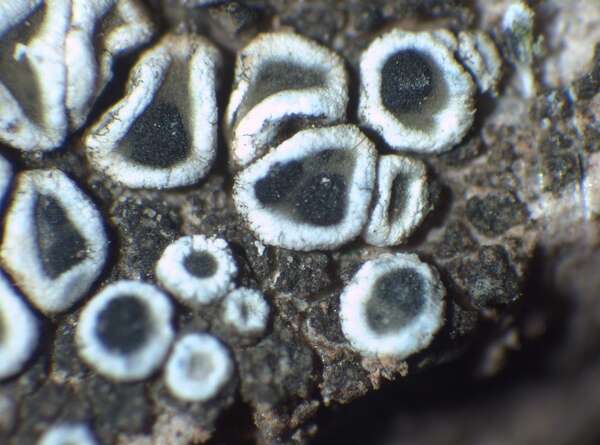

P.L. Nimis; Owner: Department of Life Sciences, University of Trieste
Herbarium: TSB (35696)
2003/01/21
in the apothecia of the host, Lecanora flotowiana
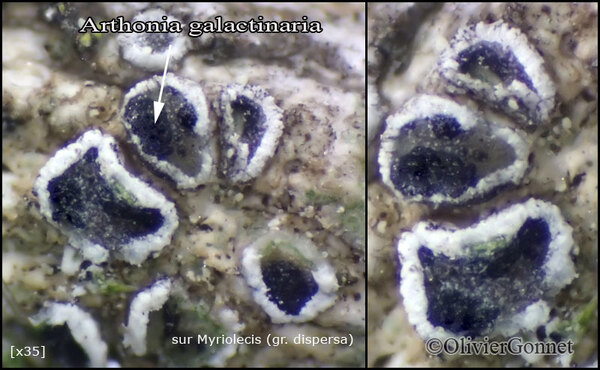
Courtesy Danièle et Olivier Gonnet - Source: https://www.afl-lichenologie.fr/Photos_AFL/Photos_AFL_A/Textes_A3/Arthonia_galactinaria.htm
France, Chalet de Laval, Névache, 2024 m - Hautes-Alpes
4/6/2017

Courtesy Danièle et Olivier Gonnet - Source: https://www.afl-lichenologie.fr/Photos_AFL/Photos_AFL_A/Textes_A3/Arthonia_galactinaria.htm
France, Chalet de Laval, Névache, 2024 m - Hautes-Alpes
4/6/2017
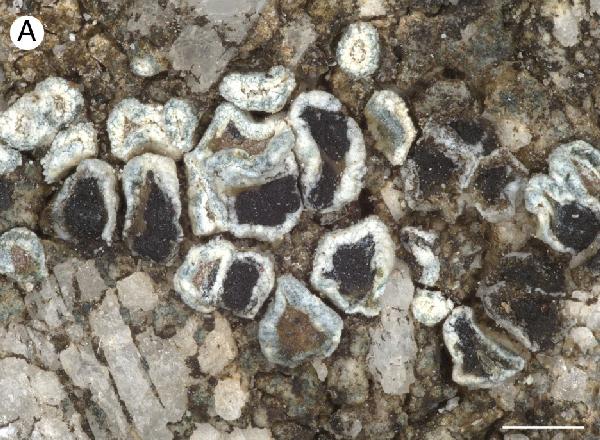
Source: Hafellner J, Grube M. Arthonia epipolytropa and Arthonia subclemens, two new lichenicolous species on Lecanora polytropa, with a key to the microfungi known on this common species. The Lichenologist. 2023;55(5):241-251. doi:10.1017/S0024282923000397 - CC BY 4.0
Arthonia subvarians (Hafellner 73605); habitus Scale: 0.5 mm.
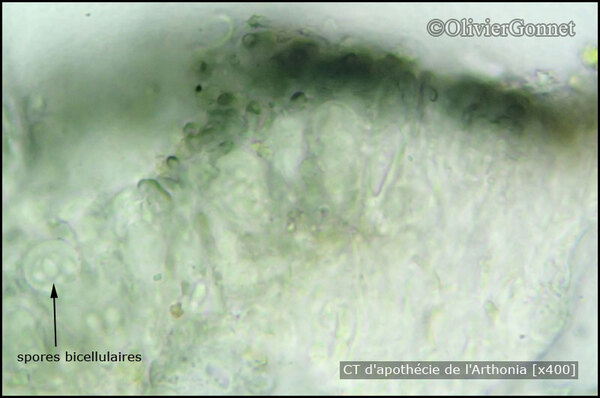
Courtesy Danièle et Olivier Gonnet - Source: https://www.afl-lichenologie.fr/Photos_AFL/Photos_AFL_A/Textes_A3/Arthonia_galactinaria.htm
France, Chalet de Laval, Névache, 2024 m - Hautes-Alpes
4/6/2017
Growth form: Lichenicolous fungus
Substrata: rocks
Reproductive strategy: mainly sexual
paras Polyozosia spp.
Commonnes-rarity: (info)
Alpine belt: absent
Subalpine belt: absent
Oromediterranean belt: absent
Montane belt: rare
Submediterranean belt: rare
Padanian area: absent
Humid submediterranean belt: rare
Humid mediterranean belt: rare
Dry mediterranean belt: rare

Predictive model
| Herbarium samples |


P.L. Nimis; Owner: Department of Life Sciences, University of Trieste
Herbarium: TSB (35696)
2003/01/21
in the apothecia of the host, Lecanora flotowiana

Courtesy Danièle et Olivier Gonnet - Source: https://www.afl-lichenologie.fr/Photos_AFL/Photos_AFL_A/Textes_A3/Arthonia_galactinaria.htm
France, Chalet de Laval, Névache, 2024 m - Hautes-Alpes
4/6/2017

Courtesy Danièle et Olivier Gonnet - Source: https://www.afl-lichenologie.fr/Photos_AFL/Photos_AFL_A/Textes_A3/Arthonia_galactinaria.htm
France, Chalet de Laval, Névache, 2024 m - Hautes-Alpes
4/6/2017

Source: Hafellner J, Grube M. Arthonia epipolytropa and Arthonia subclemens, two new lichenicolous species on Lecanora polytropa, with a key to the microfungi known on this common species. The Lichenologist. 2023;55(5):241-251. doi:10.1017/S0024282923000397 - CC BY 4.0
Arthonia subvarians (Hafellner 73605); habitus Scale: 0.5 mm.

 INDEX FUNGORUM
INDEX FUNGORUM
 GBIF
GBIF
 DOLICHENS
DOLICHENS
